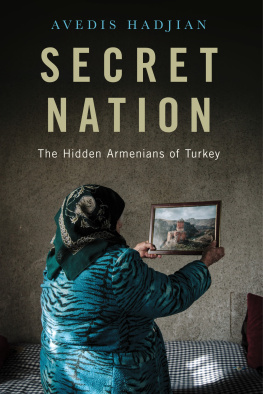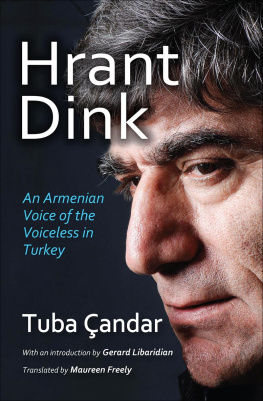TURKEY AND THE ARMENIAN GHOST
Turkey and the
Armenian Ghost
On the Trail of the Genocide
LAURE MARCHAND
AND
GUILLAUME PERRIER
Foreword by Taner Akam
Translated by Debbie Blythe

This publication was made possible by a generous grant from the Dolores Zohrab Liebmann Fund.
English translation of La Turquie et le fantme armnien : sur les traces du gnocide
McGill-Queens University Press 2015
French edition Actes Sud 2013
ISBN 978-0-7735-4549-6 (cloth)
ISBN 978-0-7735-9719-8 (ePDF)
ISBN 978-0-7735-9720-4 (ePUB)
Legal deposit first quarter 2015
Bibliothque nationale du Qubec
Printed in Canada on acid-free paper that is 100% ancient forest free (100% post-consumer recycled), processed chlorine free.
McGill-Queens University Press acknowledges the support of the Canada Council for the Arts for our publishing program. We also acknowledge the financial support of the Government of Canada through the Canada Book Fund for our publishing activities.
Library and Archives Canada Cataloguing in Publication
Marchand, Laure
[Turquie et le fantme armnien. English]
Turkey and the Armenian ghost : on the trail of the genocide / Laure Marchand and Guillaume Perrier ; foreword by Taner Akam ; translated by Debbie Blythe.
Translation of: La Turquie et le fantme armnien.
Includes bibliographical references and index.
Issued in print and electronic formats.
ISBN 978-0-7735-4549-6 (bound). ISBN 978-0-7735-9719-8 (ePDF).
ISBN 978-0-7735-9720-4 (ePUB)
1. Armenian massacres, 19151923. 2. Armenian massacres, 19151923 Historiography. 3. Armenians Turkey History. 4. Genocide Turkey. 5. Collective memory. I. Perrier, Guillaume, author II. Akam, Taner, 1953, writer of supplementary textual content III. Blythe, Deborah Mae, 1955, translator IV. Title. V. Title: Turquie et le fantme armnien. English.
DS195.5.M36713 2015 956.620154 C2014-907712-2
C2014-907713-0
This book was typeset by True to Type in 11/14 Sabon
Contents
by Debbie Blythe
by Taner Akam
follow page
Translators Preface
Translation is both an art and a science; there are no hard and fast rules. Depending on the type and purpose of the text and the target audience, translators must sometimes answer difficult questions about how faithful to be to the original, whether or not to correct errors, and how to adapt the text to a different language, time, and culture. The translation of a document of this complexity thus presented many challenges.
The subject of this book is emotionally charged of deep significance to both its authors and its readers. Faithfulness to the tone and intent of the authors and awareness of the sensibilities of potential readers were thus vital. At the same time, adaptation was required to create a coherent and accurate whole in the target language. The book is based on a series of articles written over a period of several years by French journalists Laure Marchand and Guillaume Perrier, correspondents in Turkey for Le Figaro and Le Monde. It contains a wealth of background material, evocative vignettes, horrifying first-hand accounts, and intriguing anecdotes. The story it tells is both compelling and relevant.
To do justice to this maze of detail with all its historic, geographic, literary, and cultural references, I first had to understand it. Fortunately, this task was simplified by the abundance of online documentation, including the texts of many of the books quoted, historic documents, government websites, and articles that appeared in France, Turkey, and the United States reporting the events described. Based on this research, I was able to add relevant details and explanations as appropriate always bearing in mind the needs and interests of the reader. In addition, I corrected minor inaccuracies in the original and added translators notes to incorporate explanatory material and events that have occurred since the original articles appeared.
The Turkish names and titles presented their own set of challenges. For over a thousand years, Turkish was written using a form of Arabic script. This alphabet was well suited to Ottoman Turkish, which incorporated a lot of Arabic and Persian vocabulary, but it was poorly suited to Turkish vocabulary. In 1928, as part of the sweeping cultural reforms of Turkeys first president, Mustafa Kemal, the Law on the Adoption and Implementation of the Turkish Alphabet was passed, introducing a Latin-based Turkish alphabet consisting of twenty-nine letters, seven of them modified from their Latin originals for the phonetic requirements of the language. (An explanatory note on pronunciation is included after Taner Akams preface.) Following the example of the authors, I therefore retained the use of the Latin Turkish alphabet for proper nouns and also attempted to maintain consistency in geographic names, often supplying the Turkish or Armenian names for reference.
In 1934, Mustafa Kemal introduced the Surname Law, requiring everyone in Turkey to adopt a last name. He led the way by choosing for himself Atatrk, meaning Father of the Turks. Prior to that reform, wives and children took the husbands first name as their last name, and this tradition is also reflected in the text. Finally, Turkish titles such as Bey, Pasha, and Effendi are placed after first names in the place of last names (for example, Talaat Pasha). The original version of the book is not entirely consistent with regard to the capitalization of such titles; for simplicity, they have all been capitalized.
In conclusion, it was my honour and privilege to translate this timely work. I have tried to do justice both to the original book and to the expectations of readers with the hope that this edition will play some small part in raising awareness of these tragic events and furthering the goal of genocide recognition.
Debbie Blythe
Foreword
TANER AKAM
Laure Marchand and Guillaume Perrier set themselves a daunting task: that of holding up a mirror to us Turks. But not just any mirror a mirror that would allow us to see what we do not see and to know what we do not know. Listen and look: this is your story, they say, while telling us the story of those who are not us. Their goal? To enable us to see in our own reflection those whom, to be ourselves, we have condemned to disappearance and oblivion. So that, in the end, we will come to understand who we really are.
The first question raised by this book is: Why do we Turks continue to deny the genocide? Ive been researching the question of the genocide since 1990, more than twenty years. Throughout all those years, this is the question that has arisen most consistently. It is a simple one, but as the years have passed, my answer has changed. At first, I tried to explain the denial through the concept of continuity. The Turkish Republic was established by the Union and Progress Party (Ittihat ve Terakki), the primary architect of the 1915 genocide. The founding cadres of the young Turkish state were essentially members of that party.
A significant number of the founders of modern Turkey were thus either directly involved in the Armenian genocide or enriched themselves during that period by looting Armenian properties. But those individuals were our national heroes, the founding fathers of our nation. If we had recognized the genocide, we would have had to admit that many of our greatest national figures were thieves and murderers. Yet they created our state out of nothing. We see ourselves in them, and they define who we are.
Next page





